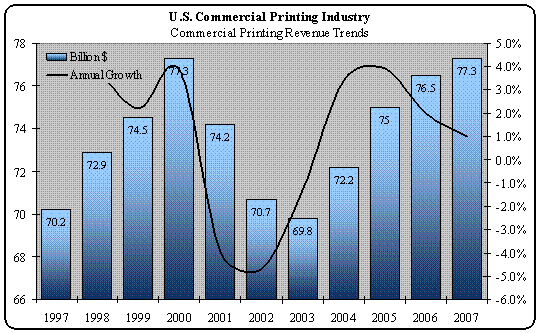Printers: Statistics
According to The Freedonia Group, Inc. (“The Freedonia Group”), a Cleveland, Ohio-based business research firm, commercial printing revenues in the United States reached $77.3 billion in 2007 based on annual growth of 1.8 percent per year from a depressed base in 2002. The Freedonia Group indicates that between 1997 and 2000, gains in revenue averaged 3.3 percent per year; however, revenues fell in 2001, 2002 and 2003. The recession that began in March 2001 negatively impacted manufacturers’ shipments and businesses of all types, which reined in expenditures including those for advertising, a key source of revenue for the commercial printing industry. A positive change in both of these indicators, which was seen during the economic recovery from 2004 onwards, led to an increased need for commercial printing for items such as packaging, catalogs, advertising and a variety of business and financial forms. Overall, the commercial printing market is very localized and foreign trade is not that significant. While there has been some interest in shifting production of less time-sensitive printing jobs to countries with lower labor costs, the growth of this trend has been curbed due to the need for both minimal shipping costs and close contact between the customer and the printer.
 Source: The Freedonia Group, Inc.
Source: The Freedonia Group, Inc.
Commercial printing processes include lithographic, digital, screen and others such as flexographic, gravure, letterpress, engraving, intaglio, thermography, embossing, debossing and foil stamping. According to The Freedonia Group, lithographic printing is the most commonly used printing process as it generated revenues of approximately $50 billion in 2007. Lithographic printing’s revenues in 2007 are based on annual gains of 0.5 percent from 2002. Lithographic printing involves the use of chemical treatment which creates image and non-image areas. Image areas are treated to repel water and accept oil-based inks, while non-image areas are treated to repel oil-based inks and accept water. The popularity of lithographic printing is due, in part, to its ability to be suitable for a variety of applications, in addition to its ability to be used with computer composition tools and provide color prints at a relatively low cost, even for mid-sized and some types of short runs. According to The Freedonia Group, digital commercial printing revenues were $7.3 billion in 2007, screen printing revenues were $6.9 billion in 2007 and revenues for all other commercial printing processes, as an aggregate, were $13.1 billion in 2007.
According to The Freedonia Group, commercial printing revenues in the United States are expected to grow 1.4 percent per year during the 2007-2012 period to reach $82.7 billion. The Freedonia Group indicates that in 2012, commercial printing will be responsible for 24.1 percent of all advertising expenditures. This will represent a decrease of 27.3 percent from 2007 as print ads, the most significant revenue producer for the industry, are replaced with online and other media advertising. Furthermore, lithographic printing will continue to generate the largest share of demand—60 percent in 2012, or $49.9 billion—virtually the same level as 2007. Revenues generated from digital commercial printing are expected to reach $11.3 billion in 2012, screen printing revenues are anticipated to reach $7.3 billion in 2012 and revenues generated by all other commercial printing processes, as an aggregate, will reach $14.3 billion in 2012.







